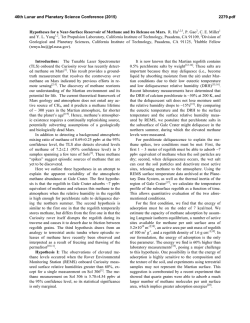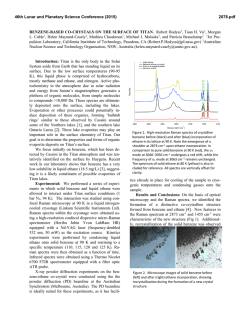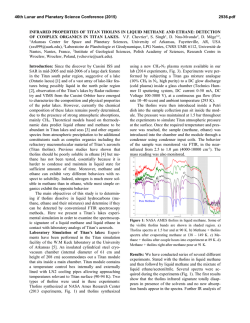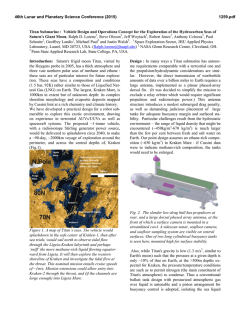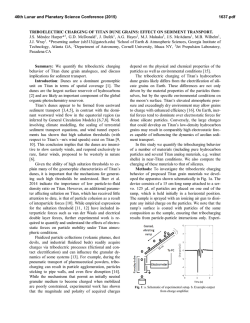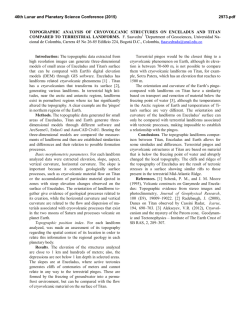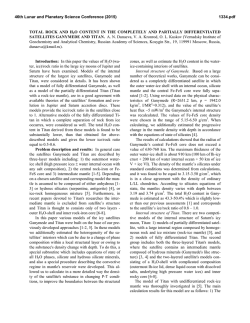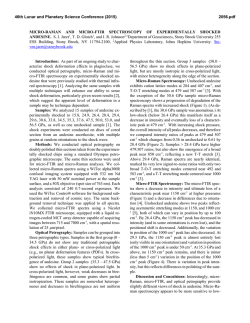
Experimental Studies of Methane Clathrate Formation and
46th Lunar and Planetary Science Conference (2015) 2484.pdf EXPERIMENTAL STUDIES OF METHANE CLATHRATE FORMATION AND SUBSTITUTION WITH ETHANE. T. H. Vu and M. Choukroun, Jet Propulsion Laboratory, California Institute of Technology, 4800 Oak Grove Dr, Pasadena, CA 91109 ([email protected], [email protected]) Introduction: Clathrate hydrates are inclusion compounds in which small guest molecules are trapped inside highly symmetric water cages. These ice-like crystalline solids are an abundant source of hydrocarbons on Earth that primarily exist in the permafrost and marine sediments. Icy celestial bodies whose pressure/temperature conditions are favorable to the formation of gas hydrates are also expected to contain substantial amounts of these materials. One such example is Saturn’s moon Titan where hydrates of methane are conjectured to be a major crustal component [1]. In addition, methane clathrate dissociation has been suggested to play a significant role in the replenishment of atmospheric methane on this satellite [2]. Release of methane from clathrates on Titan could proceed via a number of pathways: either through interaction of the clathrate layer with subsurface NH3H2O liquid or with ethane percolated from the surface lakes [3]. This research focuses particularly on the latter. Since clathrates of ethane are thermodynamically more stable than those of methane [4], a guestexchange process is expected to take place upon gassolid contact. Experiments that specifically measure the exchange kinetics would thus bring forth information on the timescales required for the substitution to occur at Titan’s conditions, thereby providing some constraints for geophysical modeling. Methods: A high-pressure apparatus, which consists of an LN2-cooled cryostage (Linkam CAP 500) equipped with a flow-pressure capillary tube, has been developed exclusively for studying the methane clathrate formation and its exchange kinetics. The entire setup is self-contained on a cart (Figure 1) and includes its own gas supplies, handling and distribution lines. Gas pressure is exerted only on the capillary tube and not on the cryostage itself. The maximum allowable working pressure inside the capillary tube is 200 bars. The capillary (Polymicro Technologies) consists of fused quartz with polyimide coating, has a square cross-section, and inner diameters of 50-100 µm. Preliminary data obtained with this system, which provide the first insights into the nature of formation and substitution processes, are presented in the Results section. Raman spectroscopy is used due to its ability to uniquely identify guest environments in various clathrate cages. All spectra are obtained with a Horiba Jobin-Yvon LabRam HR spectrometer using a fre- quency-doubled Nd:YAG crystal as laser source. The spectral resolution is 0.4 cm-1 resolution using a 1800 grooves/mm grating. Figure 1. Photograph of the high-pressure system Results: Figure 2. Kinetics of methane clathrate formation from 223-253 K at 40 bar. Inset shows Arrhenius plot where Ea is the activation energy. 1. Clathrate formation: Pressurization of small ice deposits inside the capillary tube with 40 bar of CH4 at 223-253 K results in clathrate formation within minutes. Conversion of ice into clathrates is confirmed by the presence of the characteristic peak at 2903 cm-1 which represents the symmetric stretch of methane in sI clathrate. The growth of this resonance (area normalized to that of the ice peak at ~3130 cm-1) is monitored as a function of time until it reaches a plateau 46th Lunar and Planetary Science Conference (2015) after ~2 hrs (Figure 2). A standard Arrhenius analysis (inset) yields a relatively modest activation energy of 12.3 kJ/mol. Subsequent work will examine formation kinetics at other pressures with an eventual goal elucidating the formation mechanism. 2. Clathrate substitution: Following complete conversion of ice into clathrates, excess methane gas is removed from the system. The clathrate is then treated with 30 bar of ethane at 273 K. The substitution is allowed to proceed for ~1 h until a stable product is achieved (Figure 3, black curve). Raman signatures point to the presence of a methane-ethane sI mixed hydrate after the exchange. Temperature is then increased incrementally to determine the melting point and composition of the substituted hydrate. A dissociation temperature of 287.8 K is found, which corresponds to a methane fraction of 1.6% [4]. The result suggests that, at least for small clathrate particles with high surface area, the gas replacement process takes place on a rather fast timescale, contrary to previous work with larger grain size where substitution can for last several days [5]. As such, further experiments are needed to reconcile the discrepancy and pinpoint the exact nature of the exchange kinetics. Figure 3. Substitution of methane clathrate at 30 bar ethane. Melting point of 287.8 K corresponds to a composition of 1.6% CH4 post-substitution. Acknowledgement: This work has been conducted at the Jet Propulsion Laboratory, California Institute of Technology, under contract to NASA. Support by the NASA Outer Planets Research Program and government sponsorship are acknowledged. References: [1] Lunine J. I. et al. (2009) Titan from Cassini-Huygens, Ch. 3, 35-59. [2] Choukroun M. et al. (2010) Icarus, 205, 581-593. [3] Choukroun 2484.pdf M., Sotin C. (2012) GRL, 39, L04201. [4] Sloan E. D., Koh C. A. (2008) Clathrate Hydrates of Natural Gases, 3rd ed, CRC Press [5] Murshed M. M., Kuhs W. F. (2007) Physics and Chemistry of Ice, RSC Publishing, 427-433.
© Copyright 2026
